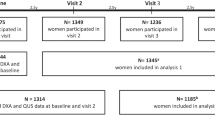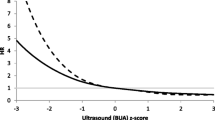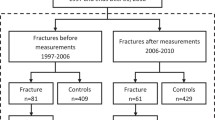Abstract
A number of prospective studies in the USA and Europe have demonstrated that quantitative ultrasound (QUS) measurements predict fracture risk. To our knowledge, there has been no such study in a Japanese population, and very few studies have measured the prognostic value of QUS measurements among men, even in the USA and Europe. We performed a three-center prospective study to investigate the relationship between baseline heel QUS measurements and non-spine fracture risk. There were 4,028 subjects (1,004 men and 3,024 women), 67.5±8.9 years [mean ± standard deviation (SD)] of age), who underwent heel QUS (Achilles device) at three centers between 1993 and 2000. In 2002, the subjects were mailed a standardized questionnaire that asked about their history of fracture. The mean follow-up period was approximately 5 years. The Achilles measured speed of sound (SOS) and broadband ultrasound attenuation (BUA). We used Cox regression analysis to determine the hazard ratio (HR), using weighted coefficients. SOS, BUA, and stiffness index (SI) predicted self-reported hip, wrist, and total non-spine fractures. After we had adjusted for age, gender, and weight, the HRs of total non-spine fracture were 1.54 [95% confidence interval (CI) 1.39–1.69], 1.53 (1.37–1.70), and 1.80 (1.62–1.98) for 1 SD decrease in SOS, BUA, and SI, respectively. In men, SOS and SI also predicted total non-spine fractures with HRs similar to those in women. The HR of prediction for hip fracture by SOS and SI was better in the short term than in the long term, and the prediction for hip, wrist, and non-spine fracture remained significant between 5 to 10 years of follow-up. Measurements obtained from heel QUS predicted non-spine fracture in Japanese men and women, and the HRs of Japanese of both genders was similar to the risk ratio (RR) of Caucasian men and women. QUS parameters can predict hip, wrist, and non-spine fracture up to 10 years.



Similar content being viewed by others
References
Scuit SCE, van der Klift M, Weel AEAM, de Laet CEDH, Burger H, Seeman E, Hofman A, Utterlinden AG, van Leeuwen JPTM, Pols HAP (2004) Fracture incidence and association with bone mineral density in elderly men and women: the Rotterdam Study. Bone 34:195–202
De Laet CE, Van Hout BA, Burger H, Weel AE, Hofman A, Pols HA (1998) Hip fracture prediction in elderly men and women: validation in the Rotterdam Study. J Bone Miner Res 13:1587–1593
The European Prospective Osteoporosis Study (EPOS) Group (2002) The relationship between bone density and incident vertebral fracture in men and women. J Bone Miner Res 17:2214–2221
Fujiwara S, Kasagi F, Masunari N, Naito K, Suguki G, Fukunaga M (2003) Fracture prediction from bone mineral density in Japanese men and women. J Bone Miner Res 18:1547–1553
Krieg MA, Cornuz J, Ruffieux C, Sandini L, Buche D, Dambacher MA, Hartl F, Hauselmann HJ, Kraenzlin M, Lippuner K, Neff M, Pancaldi P, Rizzoli R, Tanzi F, Theiler R, Tyndall A, Wimpfheimer K, Burckhardt P (2003) Comparison of three bone ultrasounds for discrimination of subjects with and without osteoporotic fractures among 7562 elderly women. J Bone Miner Res 18:1261–1266
Hartl F, Tyndall A, Kraenzlin M, Bachmeier C, Guckel C, Senn U, Hans D, Theiler R (2002) Discriminatory ability of quantitative ultrasound parameters and bone mineral density in a population-based sample of postmenopausal women with vertebral fractures: results of the Basel Osteoporosis Study. J Bone Miner Res 17:1321–1330
Njeh CF, Hans D, Li J, Fan B, Fuerst T, He YQ, Tsuda-Futami E, Lu Y, Wu CY, Genant HK (2002) Comparison of six calcaneal quantitative ultrasound devices: precision and hip fracture discrimination. Osteoporos Int 11:1051–1062
Gluer CC, Eastell R, Reid DM, Felsenberg D, Roux C, Barkmann R, Timm W, Blenk T, Armbrecht G, Stewart A, Clowes J, Thomasius FE, Kolta S (2004) Association of five quantitative ultrasound devices and bone densitometry with osteoporotic vertebral fractures in a population-based sample: the OPUS Study. J Bone Miner Res 19:783–793
Sakata S, Kushida K, Yamazaki K, Inoue T (1997) Ultrasound bone densitometry of os calcis in elderly Japanese women with hip fracture. Calcif Tissue Int 60:2–7
Hans D, Dargent-Molina P, Schott AM et al, for the EPIDOS prospective study group (1996) Ultrasonographic heel measurement to predict hip fracture in elderly women: the EPIDOS prospective study. Lancet 348:511–514
Bauer DC, Gluer CC, Cauley JA et al, for the Osteoporotic Fractures Research Group (1997) Broadband ultrasound attenuation predicts fractures strongly and independently of densitometry in older women. Arch Intern Med 157:629–634
Gregg EW, Kriska AM, Salamone LM, Roberts MM, Anderson SJ, Ferrell RE, et al (1997) The epidemiology of quantitative ultrasound: a review of the relationship with bone mass, osteoporosis and fracture risk. Osteoporos Int 7:89–99
Khaw KT, Reeve J, Luben R, Bingham S, Welch A, Wareham N, Oakes S, Day N (2004) Prediction of total and hip fracture risk in men and women by quantitative ultrasound of the calcaneus: EPIC–Norfolk prospective population study. Lancet 363:197–202
Schott AM, Kassai Koupai B, Hans D, Dargent-Molina P, Ecochard R, Bauer DC, Breart G, Meunier PJ (2004) Should age influence the choice of quantitative bone assessment technique in elderly women? The EPIDOS study. Osteoporos Int 15:196–203
Huopio J, Kroger H, Honkanen R, Jurvelin J, Saarikoski S, Alhava E (2004) Calcaneal ultrasound predicts early postmenopausal fractures as well as axial BMD. A prospective study of 422 women. Osteoporos Int 15:190–195
Hans D, Schott AM, Duboeuf F, Durosier C, Meunier PJ, on behalf of the EPIDOS Group (2004) Does follow-up duration influence the ultrasound and DXA prediction of hip fracture? The EPIDOS prospective study. Bone 35:357–363
Hans D, Njeh CF, Genant HK, Meunier PJ (1998) Quantitative ultrasound in bone status assessment. Rev Rheumatol 65:489–498
Terlizzi FD, Battista S, Cavani F, Cane V, Cadossi R (2000) Influence of bone tissue density and elasticity on ultrasound propagation: an in vitro study. J Bone Miner Res 15:2458–2466
Hans D, Wu C, Njeh CF, Zhao S, Augat P, Newitt D, Link T, Lu Y, Majumdar S, Genant HK (1999) Ultrasound velocity of trabecular cubes reflects mainly bone density and elasticity. Calcif Tissue Int 64:18–23
Gluer CC, Wu CY, Jergas M, Goldstein SA, Genant HK (1994) Three quantitative ultrasound parameters reflect bone structure. Calcif Tissue Int 55:46–52
Njeh CF, Fuerst T, Diessel E, Genant HK (2001) Is quantitative ultrasound dependent on bone structure? A reflection. Osteoporos Int 12:1–15
Cheng S, Njeh CF, Fan B, Cheng X, Hans D, Wang L, Fuerst T, Genant HK (2002) Br J Radiol 75:59–68
Pluskiewicz W, Drozdzowska B (1999) Ultrasound measurements at the calcaneus in men: differences between healthy and fractured persons and the influence of age and anthropometric features on ultrasound parameters. Osteoporos Int 10:47–51
Mulleman D, Legroux-Gerot I, Duquesnoy B, Marchandise X, Delcambre, Cortet B (2002) Quantitative ultrasound of bone in male osteoporosis. Osteoporos Int 13:388–393
Welch A, Camus J, Dalzell N, Oakes S, Reeve J, Khaw KT (2004) Broadband ultrasound attenuation (BUA) of the heel bone and its correlates in men and women in the EPIC-Norfolk cohort: a cross-sectional population-based study. Osteoporos Int 15:217–225
Takeda N, Miyake M, Kita S, Tomomitsu T, Fukunaga M (1996) Sex and age patterns of quantitative ultrasound densitometry of the calcaneus in normal Japanese subjects. Calcif Tissue Int 59:84–88
Yamazaki K, Kushida K, Ohmura A, Sano M, Inoue T (1994) Ultrasound bone densitometry of the os calcis in Japanese women. Osteoporos Int 4:220–225
Acknowledgments
This study was conducted by an ad hoc committee for “Assessment and Clinical Application of Devices of Measuring Bone Strength” of the Japan Osteoporosis Society. We thank Drs. Takami Miki (Osaka City University Graduate School of Medicine, Department of Geriatric Medicine), and Hirotoshi Morii (Osaka Osteoporosis Network) for their contributions to this study. The Radiation Effects Research Foundation (RERF), Hiroshima and Nagasaki, Japan, is a private, non-profit foundation funded by the Japanese Ministry of Health, Labor and Welfare and the US Department of Energy, the latter through the National Academy of Sciences. This publication was supported by RERF Research Protocol RP 3-89 and by a grant from the Japan Osteoporosis Foundation.
Author information
Authors and Affiliations
Corresponding author
Rights and permissions
About this article
Cite this article
Fujiwara, S., Sone, T., Yamazaki, K. et al. Heel bone ultrasound predicts non-spine fracture in Japanese men and women. Osteoporos Int 16, 2107–2112 (2005). https://doi.org/10.1007/s00198-005-2008-z
Received:
Accepted:
Published:
Issue Date:
DOI: https://doi.org/10.1007/s00198-005-2008-z




